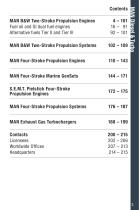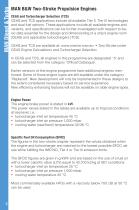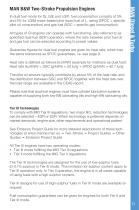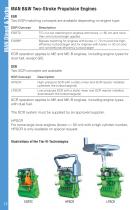
Catalog excerpts

Marine Engine Engineering the Future - since 1758.
Open the catalog to page 1
All data provided in this document is non-binding. This data serves informational purposes only and is especially not guaranteed in any way. Depending on the subsequent specific individual projects, the relevant data may be subject to changes and will be assessed and determined individually for each project. This will depend on the particular characteristics of each individual project, especially specific site and operational conditions. If this document is delivered in another language than English and doubts arise concerning the translation, the English text shall prevail.
Open the catalog to page 2
MAN B&W Two-Stroke Propulsion Engines 4-101 Fuel oil and Gl dual fuel engines 16- 91 Alternative fuels Tier II and Tier III 92-101 MAN B&W Two-Stroke Propulsion Systems 102-109 MAN Four-Stroke Propulsion Engines 110 - 143 MAN Four-Stroke Marine GenSets 144 - 171 S.E.M.T. Pielstick Four-Stroke Propulsion Engines MAN Four-Stroke Propulsion Systems 176 - 187
Open the catalog to page 3
Propulsion Engines
Open the catalog to page 5
Available on your favourite mobile device. Get the Engine Programme app from App Store, Google Play or Windows St Engineering the Future - since 1758.
Open the catalog to page 6
MAN B&W Two-Stroke Propulsion Engines MAN Diesel & Turbo Tier II and Tier III Engine Programme The two-stroke engines in this programme are either: Tier II engines complying with IMO Tier II Tier III engines complying with Tier II when operated in Tier II mode and with Tier III when operated in Tier III mode Engine Type Designation To ensure that the engine designation describes the engine with regard to the fuel injection concept and applied Tier III technologies, the engine type designation has been expanded to include these concepts, as described below (full designation, see page 15):...
Open the catalog to page 7
MAN B&W Two-Stroke Propulsion Engines CEAS and Turbocharger Selection (TCS) CEAS and TCS applications include all available Tier II, Tier III technologies and dual fuel options. These applications include all available engines and variants, and specifications can be further investigated with respect to basic data essential for the design and dimensioning of a ship’s engine room (CEAS) and applicable turbochargers (TCS). CEAS and TCS are available at: www.marine.man.eu → Two-Stroke under CEAS Engine Calculations and Turbocharger Selection. In CEAS and TCS, all engines in this programme are...
Open the catalog to page 8
MAN B&W Two-Stroke Propulsion Engines Tolerances The energy efficiency design index (EEDI) has increased focus on part-load SFOC. Therefore, we offer the option of selecting the SFOC guarantee at a load point in the range from 50% to 100%. It is recommended that the SFOC guarantee point should be limited to the range 50% to 85% for partload or low-load tuning methods. All engine design criteria, e.g. heat load, bearing load and mechanical stresses on the construction, are defined at 100% load independent of the selected guarantee point. This means that turbocharger matching, engine...
Open the catalog to page 9
MAN B&W Two-Stroke Propulsion Engines Fuel Consumption and Optimisation Possibilities for Tier II Engines Various optimisation possibilities for improved part-load and low-load SFOC are available for the MAN B&W type engines. High-load optimisation is for best possible SFOC at 100% engine load. Optimisation of SFOC in the part-load range (50-85%) or low-load range (25-70%) requires selection of a tuning method: EGB: exhaust gas bypass Also high-pressure tuning (HPT) is available on request for ME engines. The above tuning methods are available for all SMCR points, but cannot be combined....
Open the catalog to page 10
MAN B&W Two-Stroke Propulsion Engines In dual fuel mode for GI, GIE and LGIP, fuel consumption consists of 3% and 5% for LGIM mass-based pilot liquid fuel of L1 rating (SPOC = specific pilot oil consumption) and gas fuel (SGC = specific gas consumption). All types of GI engines can operate with fuel sharing, also referred to as specified dual fuel (SDF) operation, where the ratio between pilot fuel oil and gas fuel can be selected according to preset values. Guarantee figures for dual fuel engines are given for heat rate, which has the same tolerances as SFOC guarantees, i.e. see page 9....
Open the catalog to page 11
MAN B&W Two-Stroke Propulsion Engines EGR Two EGR matching concepts are available depending on engine type: EGR Concept T/C cut-out matching for engines with bores >= 80 cm and more than one turbocharger applied Bypass matching for engines with bores <= 70 cm and one highefficiency turbocharger and for engines with bores <= 40 cm and one conventional efficiency turbocharger EGR operation applies to ME and ME-B engines, including engine types for dual fuel, except GIE. SCR Two SCR concepts are available: SCR Concept High-pressure SCR with a static mixer and SCR reactor installed upstream the...
Open the catalog to page 12
MAN B&W Two-Stroke Propulsion Engines Waste Heat Recovery Systems Waste heat can be economically recovered on engines with high-efficiency turbochargers by installing equipment for waste heat recovery (WHR) and matching the engine for WHR. WHR systems are available for both Tier II and Tier III engines on request. The following types of WHR systems have been approved for application: Power turbines with a power output equal to 3-5% of the engine shaft power at SMCR. Power turbines and steam turbines with a power output corresponding to 8-10% of the engine shaft power at SMCR. Steam turbine...
Open the catalog to page 13
MAN B&W Two-Stroke Propulsion Engines Engine Dimensions The minimum length L min is stated from the aft end of the crankshaft to the fore end of the engine. L min Minimum length of engine A Cylinder distance B Bedplate width B1 Bedplate width at foot flange B2 Bedplate width at top flange C Crankshaft to underside of foot flange H1 Normal lifting procedure H 2 Reduced height lifting procedure H 3 Reduced height lifting procedure with MAN B&W double-jib crane H4 Normal lifting procedure with MAN B&W double-jib crane. Dry Masses Dry masses are stated in metric tonnes for engines with MAN...
Open the catalog to page 14All MAN Energy Solutions - Marine catalogs and brochures
-
MAN 175D
3 Pages
-
L27/38
17 Pages
-
LNG Shipping
28 Pages
-
Cruise and ferry
32 Pages
-
MAN Alpha FPP
2 Pages
-
Marine engine programme 2024
252 Pages
-
L+V48/60CR
2 Pages
-
CP pro peller
16 Pages
-
Technology for Ecology
16 Pages
-
EEDI
12 Pages
-
Alphatronic 3000
42 Pages
-
TCR TURBOCHARGER
9 Pages
-
TCA The benchmark
9 Pages
-
Marine engine programme
260 Pages
-
MAN Dual-Fuel GenSets
19 Pages
-
ME Engines
8 Pages
-
Hybrid Propulsion
9 Pages
-
Four-Stroke Marine Engines
35 Pages
-
EPROX
2 Pages
-
PRO PELLER aft ship solutions
48 Pages
-
MAN Cryo
12 Pages
-
Offshore Power Module
2 Pages
-
Ready for Tier III
6 Pages
-
MAN L51/60DF
2 Pages
-
MAN Alpha CP Propellers Mk 3
30 Pages
-
Man Alpha FP Propellers
16 Pages
-
Common Rail Technical Paper
20 Pages
-
L28/32DF GenSet
5 Pages
-
L16/24
16 Pages
-
PrimeServLube Bio P 1000
4 Pages
-
CP Propeller Mk.3
30 Pages
-
Alphatronic 2000 PCS
32 Pages
-
Alphatronic 3000 PCS
2 Pages
-
Common Rail Brochure
12 Pages
-
OBC Vessels
4 Pages
-
AHTS Propulsion
4 Pages
-
48/60
7 Pages
Archived catalogs
-
MAN Alpha FPP Retrofit Flyer
2 Pages
-
MAN Alpha Naval Propellers
16 Pages
-
VTA Project Guide
39 Pages
-
TCR The Cutting Edge
16 Pages
-
MAN-Alpha FPP Brochure
16 Pages
-
TCS-PTG TURBOCHARGER
12 Pages
-
Marine engine 2009
232 Pages

































































